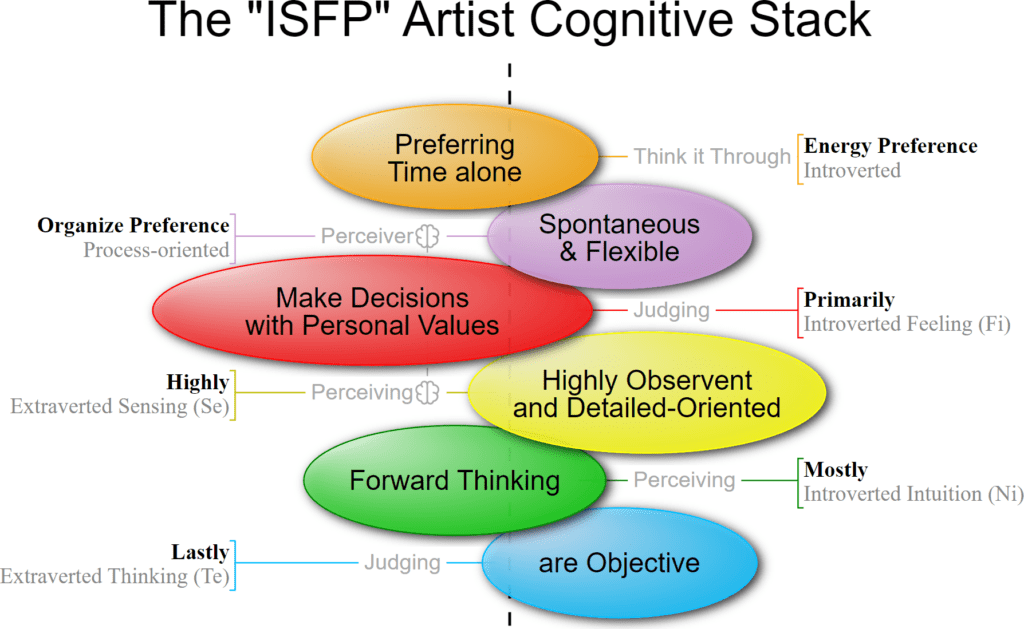What is the Keirsey ISFP “Composer” Personality Type?
The Keirsey ISFP “Composer” Personality Type is an Artisan Temperament with a Concrete Communication Style and a Utilitarian Action Style.
Keirsey organized the Four Temperaments as a matrix. There are two communication styles, abstract and Concrete, similar to the Myers-Briggs Intuition (Abstract) and Sensing (Concrete) “Perceiving” Cognitive Functions.
And by two action styles: cooperative and utilitarian. Utilitarian people, for the most part, do what works, while Cooperative people do what’s right.
Keirsey named the Four Temperaments as suggested by Plato: Artisan (Iconic), Guardian (Pistic), Idealist (Noetic), and Rational (Dianoetic).

Concrete versus Abstract Communication Style
Keirsey divided the Four Temperaments into two Communication Styles: Abstract and Concrete. These styles are similar to the Myers-Briggs Intuition and Sensing “Perceiving” Cognitive Functions.
Some people talk primarily about everyday reality’s external, concrete world: facts and figures, work and play, home and family, news, sports, and weather—all the who, what, when, where, and how of life.
Other people talk primarily about the internal, abstract world of ideas: theories and conjectures, dreams and philosophies, beliefs and fantasies—all the whys, ifs, and what might be of life.
In their daily lives, Concrete people talk about reality, while Abstract people talk about ideas.
According to Keirsey, everyone can engage in both observation and introspection. People are observant when they touch objects or otherwise perceive the world through their five senses. When people reflect and focus on their internal world, they are introspective. However, individuals cannot engage in observation and introspection at the same time. The extent to which people are more observant or reflective affects their behavior.
People who are generally observant are more ‘down to earth.’ They are more concrete in their worldview and focus on practical matters such as food, shelter, and their immediate relationships. Carl Jung used the word sensation when describing people who prefer concrete perception.
Generally, reflective people have more ‘head in the clouds’ and more abstract worldviews. They focus on global or theoretical issues such as equality or engineering. Carl Jung used the word intuition to describe people who prefer abstract perception.
Cooperative versus Utilitarian Action Style
Some people act primarily practically or pragmatically; that is, they do what gets results, what achieves their objectives as effectively or efficiently as possible. They only check afterward to see if they observe the rules or go through the proper channels.
Other people act primarily cooperatively or socially acceptable; they try to do the right thing in keeping with agreed-upon social rules, conventions, and codes of conduct. Only later do they concern themselves with the effectiveness of their actions.
These two ways of acting can certainly overlap, but as they lead their lives, utilitarian people mostly do what works, while cooperative people do what’s right.
Keirsey compares the differing temperaments with cooperative (Complying) and pragmatic (Adaptive) temperaments. Cooperative people pay more attention to other people’s opinions and are more concerned with doing the right thing. Sensible people (Utilitarian) pay more attention to their thoughts or feelings and are more concerned with doing what works. No comparable idea in the MBTI or Jung corresponds to this dichotomy, a significant difference between Keirsey’s work and Myers and Jung’s.
The pragmatic temperaments are Rational (pragmatic and abstract) and artisan (Pragmatic and concrete). The Cooperative Temperaments are Idealists (Cooperative and Abstract) and Guardians (Cooperative and Concrete). Neither the MBTI nor Jung included the concept of Temperament in their work.
ISFP Keirsey/MBTI Correlation
| Keirsey | MBTI | |
|---|---|---|
| I | Attentive Role Variant | Introverted Feeling |
| S | Concrete Communication Style | Extraverted Sensing Auxiliary Function |
| F | Informative Role | Introverted Feeling Dominate Function |
| P | Utilitarian Action Style | Sensing is a Perceiving Function |
With Extraverted Sensing as the second Auxiliary Function and Introverted Feeling as the first Dominant Function, the MBTI ISFP “Artist” Personality Type sorts to the Keirsey ISFP “Composer” Personality Type.

ISFP Personality Type cross-reference
- Keirsey Type – Composer
- Temperament Type – Sanguine
- Animal Type – Golden Retriever
- DISC Type – Steadiness
- Socio-Communicative Type – Amiable
- True Colors – Orange
- Color Code – Yellow
- Personality Compass – South
- Occupational Type – Conventional
- Learning Type – Reflector
- Leadership Type – Accommodator
Enneagram Types
Composer Personality Characteristics
Compared to the other Artisans, Composers are in tune with their senses and have a sure grasp of what belongs and what doesn’t in all kinds of art.
While the other Artisans are skilled with people, tools, and entertainment, Composers have an exceptional ability-seemingly inborn work with subtle differences in color, tone, texture, aroma, and flavor.
Although Composers often put long, lonely hours into their artistry, they are just as impulsive as the other Artisans.
They do not wait to consider their moves but act here and now without planning or preparation. Composers are seized by artistic composition as if caught up in a whirlwind. The act is their master, not the reverse.
Composers paint or sculpt, dance or skate, write melodies, or make recipes- or whatever- because they must.
They climb the mountain because it is there. This ability to lose themselves in action accounts for the spectacular individual accomplishments of some Composers, and yet, on their social side, they show a kindness unmatched by all the other types.
Composers are especially sensitive to the pain and suffering of others, and they sympathize freely with the sufferer.
Some have a remarkable way with young children, almost as if they had a natural bond of sympathy and trust.
Composers are just as plentiful as the other Artisans, say nine or ten percent of the population, but they are generally complicated to observe and thus greatly misunderstood.
Very likely, the difficulty comes from their tendency not to express themselves verbally but through their works of art.
Composers are usually not interested in developing public speaking or conversational skills; they prefer to feel the pulse of life through touch, in the muscles, in the eyes, in the ears, and on the tongue.
Composers are just as interested as other types in sharing their view of the world, and if they find a medium of non-verbal communication art form, they will express their character quite eloquently.
If not, they remain unknown, their quietness leaving their nature invisible.
Famous Composers
Bob Dylan, Jackie Kennedy Onassis, Cher, Wolfgang Amadeus Mozart, Mel Brooks, Steven Spielberg, and Neil Simon are examples of Composer Artisans.

What are the Keirsy Personality Temerpaments?

David Keirsey, born in 1921, was an American psychologist specializing in conflict management and family counseling. He began researching human behavior and Personality in the 1940s.
Keirsey blended the Myers-Briggs Personality Types with Ernst Kretschmer’s model of the Four Temperaments, developing the Keirsey Temperament Sorter, which was made famous by his book “Please Understand Me.”
Instead of using the term Personality, Keirsey used Temperament. He viewed it as a configuration of observable Personality Traits, communication habits, patterns of action, characteristic attitudes, values, and talents. To Keirsy, Temperament encompasses personal needs, individual contributions, workplace contributions, and societal roles.
Keirsey correlated the sixteen MBTI Personality Types into Four Temperaments. He divided each Temperament into two Roles: informative and Directive. He subdivided the roles into expressive (extraverted) and attentive (introverted) role Variables.
Informative versus Directive Roles
Keirsey distinguishes between people who generally communicate by informing others versus those who speak by directing others. This distinction subdivides each of the four Temperaments into eight Roles.
Expressive versus Attentive Role Variants
Individuals who act before observing are Expressive. In contrast, people who follow before working are Attentive.
Expressive and attentive variants further subdivide the eight roles into 16 types correlating to the 16 Myers-Briggs personality types.


